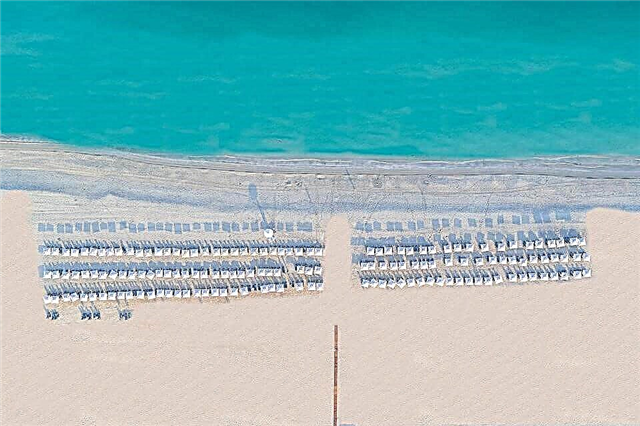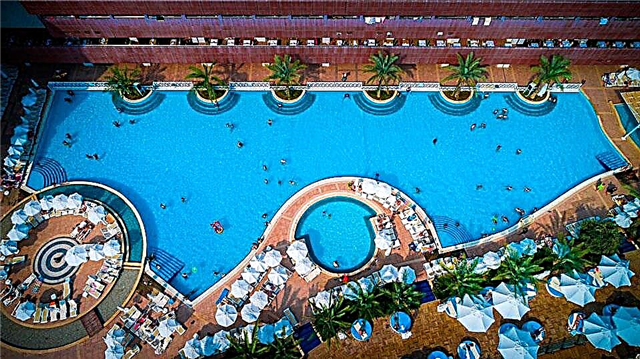Svyato-Vvedenskaya Optina Pustyn stands at the confluence of Klyutoma and Zhizdra and occupies the territory adjacent to Kozelsk. The attendants of the stauropegic monastery are men. The desert itself remains one of the oldest monasteries, which has been perfectly preserved to this day.
History of the monastery
From the monastery chronicle it becomes clear that the institution was founded in the 15th century by a hermit named Opta. Before accepting monasticism, he was a robber, but over time he repented of what he had done and wished to devote his life to serving the Almighty.

A bird's eye view of the monastery
Taking monastic vows under the name of Macarius, the newly made monk began to equip the territory of the desert. However, another belief refutes this version, claiming that the monastery was built by the ascetics themselves, who received a sign from above. They expressed repentance for their early sins with tireless work and sincere prayers.
After the completion of construction and up to 1504, the monastery was inhabited by both elders and old women. However, subsequently, a ban was imposed on the residence of monks and nuns on the same territory, and the monastery turned into an exclusively male institution.

General view of the monastery
In 1689, the first stone temple appeared on the territory of the desert. With the aim of expanding it, the Romanov dynasty assigned the lands to the monastery. But under Peter I, the Optinskaya Hermitage was abolished - due to its small number, it could not pay considerable fees. However, a similar fate then affected many monasteries.
Since 1724 new times have come for the desert - it is ranked among the complex of the Belevsky Spaso-Preobrazhensky Monastery. But a couple of years later, thanks to the petitions of the steward Shepelev, the monastery again becomes an independent institution. However, these changes did not affect his financial well-being, he continued to exist without public funds. Of course, the local boyars provided the monastery with all possible assistance, but they were not enough to maintain the courtyard in excellent condition. Therefore, wooden buildings were dilapidated until 1764.

Holy gates of the monastery
The heyday of Optina desert
The stage of the revival of the Holy Vvedensky Monastery begins with a visit by Metropolitan Platon Levshin (a memorable visit dates back to 1796). Struck by the unprecedented beauty of the area, he set about restoring the communal sphere of the desert. At that time, only 3 people represented the brethren of the monastery, and none of them was a priest.
By the intercession of the Metropolitan of Moscow, the abbot of the monastery was appointed - Hieromonk Abraham took office (the venerable elder arrived from the Pesnosh Hermitage). A year passed, and the brethren consisted of a dozen people. But the spiritual flourishing of the Kozelsk stauropegic monastery came only in the 20s of the 19th century, when the Bishop of Kaluga signed a decision on its improvement.

Monastery walls
The annexation of Optina Hermitage to the Kaluga Diocese did her only good, because she received such a serious trustee as Bishop Theophylact of Kaluga. In 1809, the population of the monastery already consisted of 30 people. With the arrival of the new confessor, Archimandrite Moses, in the desert, eldership is revived, that is, a special spiritual and guardian activity. It is noteworthy that both members of the brethren and ordinary people who visited the desert could turn to the holy elders for help and advice. So the once wretched institution turned into one of the significant spiritual centers located on Russian soil.

Bell tower (left), Church of the Kazan Icon of the Mother of God (center)
Every year the number of monks in the monastery increased and by the end of the 19th century it had reached two hundred souls. In the same years, thanks to the efforts of the Optina elders, the Kaluga land was replenished with three more monasteries, but this time for women. These are the Kazan Holy Amvrosievskaya hermitage, the Dugnensky monastery "Joy and Consolation" and the Kazan Belopytovskaya community.
Holy churches - components and sights of Optina Pustyn
Architecturally, the monastery courtyard looks like a square space protected by a stone wall. The fence was erected from 1832 to 1839.

Church of the Transfiguration of the Savior
Today the following temples and chapels are located on the territory of the monastery and behind its side-altars:
- The main temple commemorating the Introduction to the Temple of the Most Holy Theotokos and preserving the relics of all the Optina elders and the monks Nektarios and Ambrose.
- Temple in honor of the Kazan Icon of the Mother of God - the largest of all the Optina shrines. Here lie the relics of Anthony, Moses and Isaac I. The premises are used for Sunday and festive services.

Church of the Vladimir Icon of the Mother of God
- Temple of the Vladimir Icon of the Mother of God - a new building that appeared on the site of a destroyed shrine. The tomb temple became the repository of the relics of the seven elders. The ceremony of her consecration took place in 1998.
- From the north of the Vvedensky Cathedral you can see Church of St. Mary of Egypt... The one-domed temple in the best traditions of classicism was restored in the 2000s.
- The church in St. John the Baptist Skete appeared in 1825. With its construction the craftsmen honored St. John the Forerunner and Baptist of the Lord.

From left to right: Church of Mary of Egypt and Anna the Righteous, Cathedral of the Presentation of the Most Holy Theotokos in the Temple
- Not far from the holy gates rises a small Church of the Transfiguration of the Savior, which is considered a symbol of the reviving monastery.
- The temple, rebuilt in 1874 in memory of the Monk Hilarion the Great, stands outside the walls of the monastery.
- The temple called "The Contestant of Breads" was built already in 2000. You can find it on the plot of the subsidiary farm.
- In 1993, on the monastery necropolis, a small wooden belfry.

Church of St. Mary of Egypt
- In 2008, in memory of the three dead monks at the place of their burial, the inhabitants erected a tiny Chapel of the Resurrection of Christ.
- One more canopy chapel with a mosaic icon of the Mother of God meets tourists and pilgrims near the southern gate.
It is quite natural that the monastery has its own bell tower... Initially, it was built in 1802 - 1809, but due to the closure of the desert, its building was destroyed in due time. The restoration of the bell tower was carried out in 1999.

Cathedrals of Optina Hermitage from above. In the foreground is the bell tower, behind it is the Vvedensky Cathedral and the Church of the Vladimir Icon of the Mother of God, to the left of the Vvedensky Cathedral is the Church of St. Mary of Egypt, to the right is the Church of the Kazan Icon of the Mother of God
Now the desert works for its intended purpose. Holidays and services are held in all churches. As in the distant past, and to this day, the relics of the venerable elders, which found peace in the Kazan, Vvedenskaya and Vladimir shrines, are considered the main values of the monastery.

Bell tower of the monastery
Optina Hermitage is the favorite place of Patriarch Alexy II of Moscow and All Russia - the clergyman comes here quite often.
Attraction rating:











